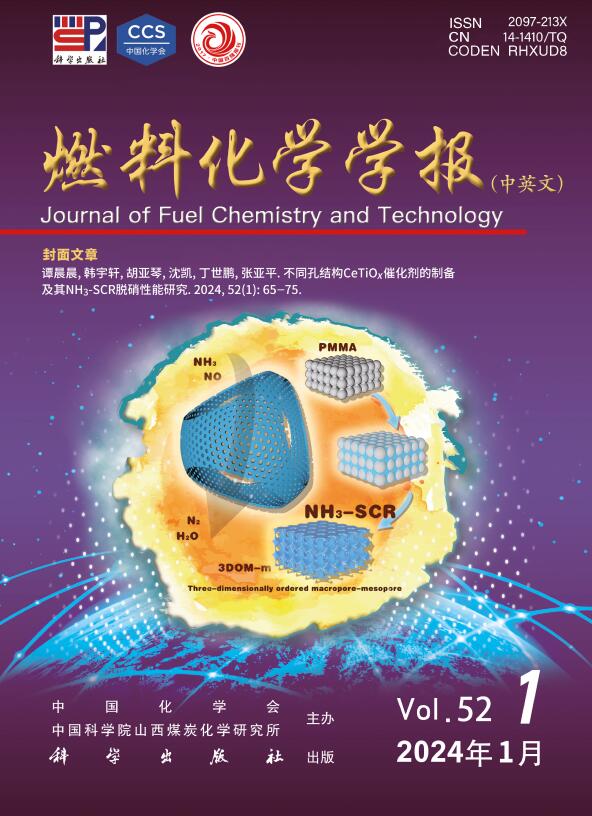Mn-V-O二元氧化物的制备及其有氧氧化脱硫的催化性能
Q3 Energy
引用次数: 0
摘要
好氧氧化脱硫(AODS)是一种经济、可持续的石油馏分脱硫方法,需要高性能的催化剂在温和的反应条件下将硫化物转化为硫酮。采用水热法合成了片状Mn-V-O二元氧化物。采用傅立叶变换红外光谱(FT-IR)、x射线衍射(XRD)、扫描电子显微镜(SEM)和x射线光电子能谱(XPS)等多种技术对催化剂的晶体相、形貌和表面性质进行了研究。以氧为氧化剂考察了Mn-V-O二元氧化物催化剂的脱硫性能,考察了反应温度、催化剂用量、氧流量和硫化物种类对脱硫率的影响。结果表明,在反应温度为110℃、模型油20 mL、催化剂0.04 g、氧气流量为150 mL/min的条件下,脱硫率可达92.5%。不同硫化物的去除率顺序为:二苯并噻吩(DBT) >;4,6-二甲基二苯并噻吩(4,6- dmdbt) >;苯并噻吩(BT)。该催化剂可重复使用5次,同时保持90%以上的脱硫活性。自由基捕获实验表明,在催化剂和氧气的存在下产生超氧自由基,将DBT有效氧化为DBTO2。本文章由计算机程序翻译,如有差异,请以英文原文为准。
Preparation of Mn-V-O binary oxides and their catalytic performance for aerobic oxidative desulfurization
Aerobic Oxidative Desulfurization (AODS) represents an economical and sustainable approach for the desulfurization of petroleum distillates, requiring high-performance catalysts to convert sulfides into sulphones under mild reaction conditions. The sheet-like Mn-V-O binary oxides were synthesized using a straightforward hydrothermal process. The crystal phase, morphology, and surface properties of the catalyst were examined using various techniques, including Fourier transform infrared spectroscopy (FT-IR), X-ray diffraction (XRD), scanning electron microscopy (SEM), and X-ray photoelectron spectroscopy (XPS). The desulfurization performance over the catalyst of Mn-V-O binary oxides was assessed using oxygen as the oxidant, and the effects of reaction temperature, catalyst dosage, oxygen flow rate, and sulfide type on the desulfurization rate were investigated. The results indicate that when the reaction temperature is maintained at 110 °C, with 20 mL of model oil, 0.04 g of catalyst and an oxygen flow rate of 150 mL/min, the desulfurization rate can achieve 92.5%. The order of removal rate for different sulfides is as follows: dibenzothiophene (DBT) > 4,6-dimethyldibenzothiophene (4,6-DMDBT) > benzothiophene (BT). The catalyst can be reused up to five times while maintaining a desulfurization activity above 90%. Free radical capture experiments have demonstrated that the superoxide radicals are generated in the presence of the catalyst and oxygen, which effectively oxidize the DBT to DBTO2.
求助全文
通过发布文献求助,成功后即可免费获取论文全文。
去求助
来源期刊

燃料化学学报
Chemical Engineering-Chemical Engineering (all)
CiteScore
2.80
自引率
0.00%
发文量
5825
期刊介绍:
Journal of Fuel Chemistry and Technology (Ranliao Huaxue Xuebao) is a Chinese Academy of Sciences(CAS) journal started in 1956, sponsored by the Chinese Chemical Society and the Institute of Coal Chemistry, Chinese Academy of Sciences(CAS). The journal is published bimonthly by Science Press in China and widely distributed in about 20 countries. Journal of Fuel Chemistry and Technology publishes reports of both basic and applied research in the chemistry and chemical engineering of many energy sources, including that involved in the nature, processing and utilization of coal, petroleum, oil shale, natural gas, biomass and synfuels, as well as related subjects of increasing interest such as C1 chemistry, pollutions control and new catalytic materials. Types of publications include original research articles, short communications, research notes and reviews. Both domestic and international contributors are welcome. Manuscripts written in Chinese or English will be accepted. Additional English titles, abstracts and key words should be included in Chinese manuscripts. All manuscripts are subject to critical review by the editorial committee, which is composed of about 10 foreign and 50 Chinese experts in fuel science. Journal of Fuel Chemistry and Technology has been a source of primary research work in fuel chemistry as a Chinese core scientific periodical.
 求助内容:
求助内容: 应助结果提醒方式:
应助结果提醒方式:


